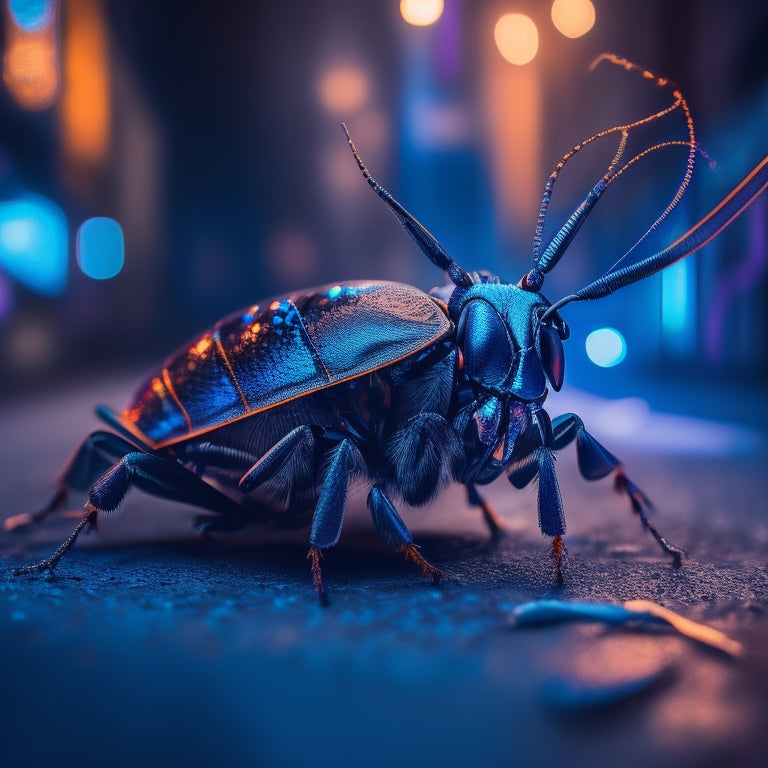
Unleash Control: Transform Cockroach Into Cyborg
Share
You're about to harness the power of neurotechnology to take control of a cockroach's nervous system, effectively transforming it into a cyborg insect under your precise command. To do this, you'll develop a neural interface for microstimulation, using the RoboRoach kit's technology to modify behavior through neurotechnology. Next, you'll surgically implant the interface, ensuring precision and insect well-being. As you explore the intersection of biology, engineering, and robotics, you'll consider ethical implications and limitations. Now, get ready to harness the full potential of cyborg invertebrates - there's more to discover in this groundbreaking fusion of tech and biology.
Key Takeaways
• Develop a neural interface for precise control of the cockroach using RoboRoach kit's microstimulation technology.
• Ensure the well-being of the insect during the surgical procedure by anesthetizing and securing it properly.
• Implant the neural interface and microstimulation system carefully through a small incision in the thorax.
• Analyze the behavior modification effects of microstimulation on the cockroach and observe neural adaptation.
• Consider ethical implications in insect robotics and prioritize the insect's well-being throughout the experiment.
Experiment Overview and Background
As you begin on this fascinating experiment, transforming a cockroach into a cyborg, you'll explore the intersection of biology, engineering, and robotics, gaining hands-on experience with a cutting-edge technology that's been previously reserved for advanced research institutions.
This innovative project holds significant scientific value, enabling you to investigate the field of neurotechnology advancements. By participating in this experiment, you'll not only engage with complex concepts but also contribute to the development of cyborg invertebrates, sparking essential discussions on ethical considerations.
As you set out on this journey, you'll discover the importance of responsible innovation, ensuring that your pursuit of knowledge aligns with moral principles. By embracing this experiment, you'll be part of a pioneering effort, pushing the boundaries of interdisciplinary research and inspiring future generations of students to explore the uncharted territories of science and technology.
Cyborg Creation and Control
To create a functional cyborg, you'll need to develop a neural interface that can precisely control the cockroach's movements, leveraging the RoboRoach kit's advanced microstimulation technology to harness the insect's natural behavior.
This involves behavior modification, where you'll use neurotechnology to stimulate the cockroach's nervous system, influencing its movements and actions.
As you venture into insect robotics, bear in mind the ethical implications, ensuring that your experiments prioritize the well-being of the insects.
Surgical Procedure and Equipment
What tools and techniques will you employ to successfully implant the neural interface and microstimulation system into the cockroach's nervous system?
You'll need to guarantee equipment sterilization and maintain surgical precision throughout the procedure.
Begin by anesthetizing the cockroach and securing it in a stereotactic device.
Then, make a small incision in the cockroach's thorax to access the nervous system.
Using a micromanipulator, carefully implant the neural interface and microstimulation system, taking care not to damage surrounding tissues.
The neural interface will serve as the control mechanism, allowing you to stimulate the cockroach's nervous system and control its movements.
With the correct techniques and tools, you'll be able to successfully transform the cockroach into a cyborg.
RoboRoach Development and Limitations
You'll be exploring a sophisticated device when using the RoboRoach kit, which has been engineered to enable precise neural control of the cockroach's movements. As you immerse yourself in the world of cyborg invertebrates, it's crucial to comprehend the development and limitations of this technology.
Here are key aspects to keep in mind:
-
Ethical considerations: Make sure you're aware of the guidelines for neural microstimulation and experiment with the utmost respect for the cockroach's well-being.
-
Neural adaptation: Observe how the cockroach's nervous system adapts to the microstimulation, and take note of any changes in behavior.
-
Regulatory guidelines: Familiarize yourself with the regulations surrounding neural microstimulation and experimentation on invertebrates.
- Behavior modification: Analyze the modified behavior of the cockroach and its implications for future research.
Project Ideas and Community Sharing
As you've mastered the RoboRoach's neural control, now's the time to take your experiment to the next level by designing innovative science fair projects that explore the boundaries of cyborg invertebrates. You can investigate behavior modification through data analysis, examining how microstimulation affects the cockroach's natural behavior. Consider ethical considerations, ensuring your project doesn't harm the insects and contributes positively to the community.
| Project Ideas | Community Sharing |
|---|---|
| Investigate variable stimulation frequencies | Share experiment worksheets and results |
| Analyze cockroach adaptation to microstimulation | Discuss ethical considerations and community impact |
| Compare induced behavior to natural behavior | Collaborate on new project ideas and variations |
| Explore the effects of microstimulation on cockroach learning | Share tips and tricks for successful RoboRoach surgeries |
Frequently Asked Questions
How Do I Ensure the Cockroach's Well-Being During the Experiment?
Did you know 80% of animals used in research are invertebrates like cockroaches? To guarantee the cockroach's well-being, you'll follow humane handling and ethical treatment guidelines, prioritizing gentle restraint, minimal stress, and careful monitoring to prevent harm during the experiment.
Can I Use Other Insects Besides Cockroaches for the Cyborg Experiment?
You can explore insect diversity for cyborg experiments, but species selection is vital; consider factors like nervous system complexity, size, and behavioral adaptability when choosing an alternative insect to guarantee a successful transformation.
What Is the Average Lifespan of a Roboroach After Surgery?
You'll find that the average lifespan of a RoboRoach after surgery depends on post-op care and longevity factors, such as nutrition, humidity, and handling, which can range from a few weeks to several months with ideal conditions.
Are There Any Potential Safety Risks to the Experimenter During the Procedure?
As you conduct the procedure, you'll want to guarantee your safety by wearing personal protective equipment, such as gloves and goggles, and maintaining laboratory sterilization to minimize risk of infection and exposure to potential allergens.
Can I Reuse the Neural Interface Components for Multiple Cockroaches?
You'll want to assess component compatibility before reusing neural interface components for multiple cockroaches, ensuring neural flexibility isn't compromised; clean and sterilize components thoroughly to prevent cross-contamination and maintain peak performance.
Related Posts
-

Modular Storage for Bathroom Decluttering
Modular storage is your solution for effective bathroom decluttering. It maximizes every inch of space, allowing cust...
-

Drawer Inserts for Maximizing Bathroom Cabinet Space
When it comes to maximizing your bathroom cabinet space, custom drawer inserts can be a revolutionary solution, revea...
-

Lightware Academy Revolutionizes Pro AV E-Learning
Lightware Academy is revolutionizing Pro AV e-learning with its all-encompassing online platform, offering certified ...


